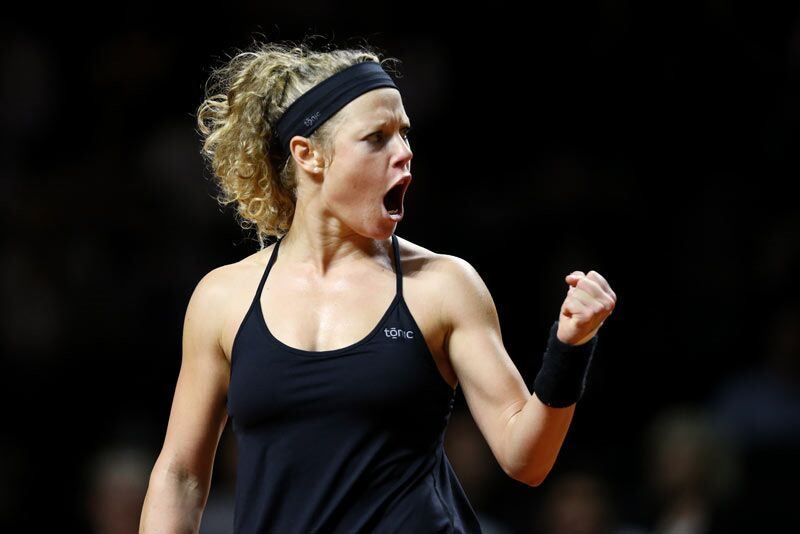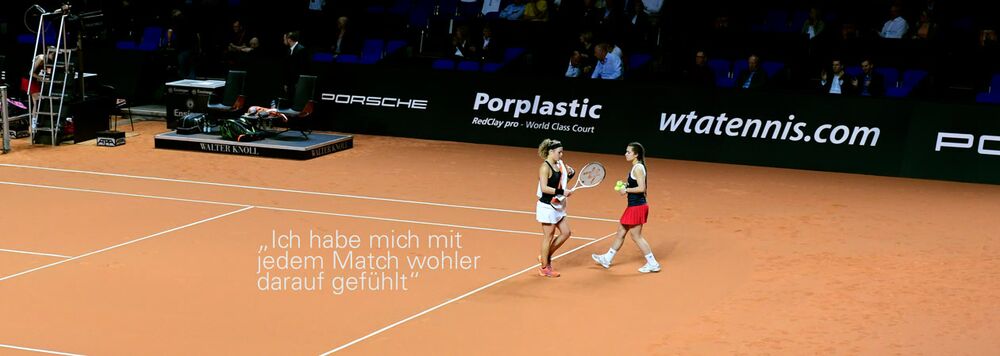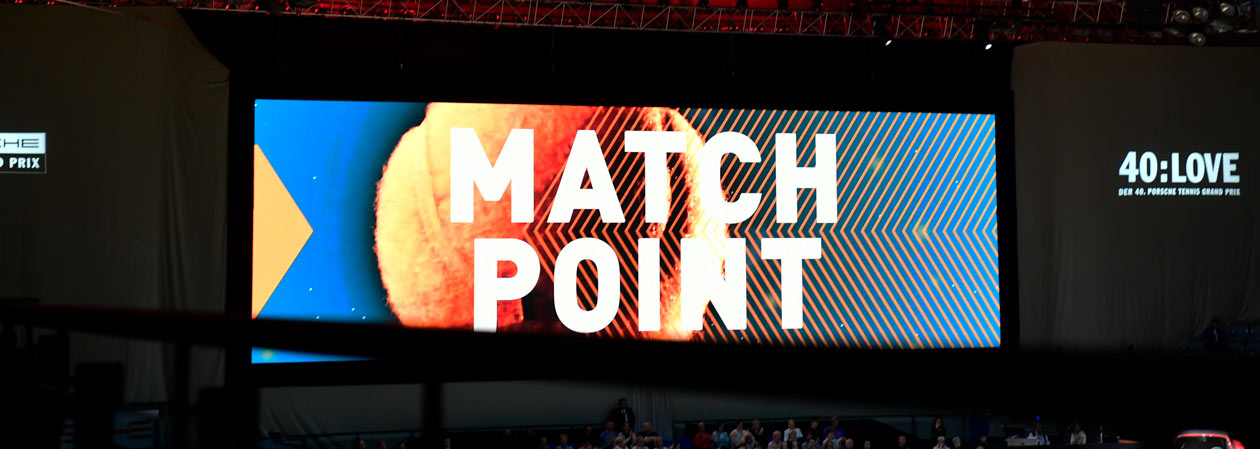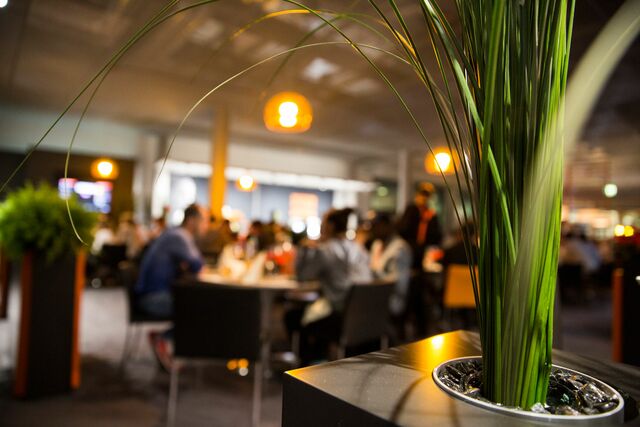The winner
An enjoyable and fun meeting.Despite having little time and it being so close to Christmas, the winner of the PORSCHE TENNIS GRAND PRIX tournament in 2017 managed to fit us in between her training and press commitments.


Despite having little time and it being so close to Christmas, the winner of the PORSCHE TENNIS GRAND PRIX tournament in 2017 managed to fit us in between her training and press commitments.
"I’ve just managed to work really hard on improving myself and have always worked really hard on my game as well as my outlook."
She was very relaxed and we had an enjoyable and fun meeting.
Laura Siegemund has experienced a career with highs and lows but she says this has made her who she is today.
After having ended her professional career, she studied Psychology, achieving her Bachelor of Science and then went on to gain her DTB A Trainer coaching licence. She then fought her way right back up the tennis rankings as a professional tennis player. She was picked for the Fed Cup team, represented her country at the Rio Olympics, rose up to 26th in the world rankings and won her only WTA tournament in Stuttgart, but she then suffered a serious injury, a cruciate ligament rupture.
However, Laura Siegemund wouldn’t be Laura Siegemund if she hadn’t given everything she had to bounce back and come out on top. This required discipline, extreme determination and a positive outlook. These are all things that Laura has in abundance.
VIACOR Polymer GmbH was the official court supplier for the PORSCHE TENNIS GRAND PRIX tournament for the first time in 2017. We are so proud that a local girl triumphed on our PORPLASTIC RedClay pro. We have loads of questions about courts and the life of a tennis player who hails from the local area.
VIACOR: What from the viewpoint of a tennis players is important for a tennis surface with respect to clay courts?
Laura Siegemund: I really enjoy playing on sand, and it’s really important that the court is level. On sand courts, the balls bounce higher through the accumulation of sand caused by running movements on the court. There are some really hard sand courts, such as Paris, where the sand is pressed into the ground, and these courts are very fast. If it was up to me, I would be happy for there to be more sand on the court, making it slower as a result.
The lines are also important – they shouldn’t stand out too much. The lines belong to the court, and it’s a real shame when the movement of the ball is affected by lines which are too high, which then makes the ball unplayable. The lines shouldn’t have a negative impact on the game.
Lastly, the court should be even. It’s really hard when certain areas of the court are hard and grippy and other parts are slippery. This can be dangerous for the player. Even hard courts need to be even, which isn’t always the case. There are hard courts which have ripples on them or even have a slope. It’s vital that the whole of the court is consistent, level and even.
V: Was there a difference between the courts at the PORSCHE TENNIS GRAND PRIX in 2016 and in 2017?
LS: Yes, it’s different every time really, not just from one year to the next but also between the courts within the tournament complex. Centre Court is always different to the courts in the Schleyer Arena, which differ again from the training courts. As a professional, you notice these things, but this goes with the territory and you have to adjust, be flexible and not worry too much, even if at the beginning of a match or a training session you have to get a feel for the court first.
V: How did the court change from the beginning of the tournament to the end?
LS: In 2016 the court was extremely slippery. It wasn’t easy to play on, especially for a hard-running player like me, and you’re not able to return from the corners of the court very quickly. This year, right from the start, the courts were much less slippery. In fact during the first few days, the courts were bouncy, many balls took a bad bounce and the sand wasn’t firm on the surface. On the outside areas when you tread on small holes in the ground, which are formed as the sand loosens, it can become dangerous for the player and present an injury risk. Courts like this need to be left to settle so the sand can become bedded in. The more a court is played on, the more level the surface becomes during the week.
LS: It’s part and parcel of our job that we have to learn to adjust to the challenge of different playing conditions. There are courts you enjoy playing on and there are some you enjoy less. As a professional, you have to accept it how it is and make the best out of it. Maybe I’m more tolerant and try to make the best out of any given situation, whether it’s the court surface, weather conditions or something else, and use it to my advantage instead of letting it bother me.
In the last two years I quickly adjusted to the surface as the tournament in Stuttgart progressed and I felt more comfortable with every match I played. But it is a particular kind of surface. It’s a sand surface, and as it’s indoors, it’s different from the usual sand courts which we play on outdoors in the summer.

V: How are you finding it on the court since your injury and are you suffering any adverse effects?
LS: Of course, the rehabilitation after such an injury is a long and time-consuming process. To come back from a cruciate ligament rupture, you need to work hard from day one, at first from the psychological point of view, then working more and more on strength and rehabilitation training, and then back on the court to train the movements which are more specific to tennis itself. I’ve been back on the court for some time now and am working on my game. It’s natural that there are psychological barriers at first, as the body isn’t used to the many movements and you have to slowly introduce it back to the strains. But I’m really enjoying getting ever closer to where I was before the injury. During a period of rehabilitation, you really get to know your body (and appreciate it) all over again and the training is considered and cautious. This, in itself, has been a great experience but the best thing is that I can spend more time fine-tuning my game, whilst losing the worry about moving around the court and being able to play with freedom once again. This is when you realize how much enjoyment movement, even strenuous movement around the court, gives you and how much you have missed it.
V: There are only photos of a positive-looking Laura. Is there also a sad Laura?
LS: I really am a very positive person, but of course it’s not always peace, happiness and harmony. There is no such person. In competitive sport the highs and lows can happen very close together. During a long rehabilitation process after such a serious injury there are going to be some dark moments which you have to overcome. But I do think that if you can get over this, it can make you stronger than before. I think that the most difficult times can give you the opportunity to develop as a person, if you use the time wisely. I used the time during my injury to work on myself, and not just on my physical rehabilitation but also on my mental attitude and outlook. I try not to use up my energy worrying about things that I can’t change. I would rather concentrate on the possibilities which are open to me.
V: You’ve long had the talent potential without managing the breakthrough but to see you playing now, you seem like a changed person. A 100 % focussed powerhouse. What’s caused this change?
LS: I wouldn’t quite say it like that. I’ve always played in a concentrated and focussed way and have always had boundless energy, on and off the court. Also the creativity which can bring a difference to my game has always been there. But this didn’t always translate into results, especially not on the large stage, where the media would have noticed. In terms of ability there isn’t a large difference between 50 and 100 in the world rankings, there is so much quality at the top of the game. But media interest is completely different if you are 100 compared to 50 in the world. For a long time, I definitely wasn’t able to just relax and let things happen and to accept that, despite being very ambitious, you can’t force success. On some occasions I also didn’t have that little bit of luck which you sometimes need to gain self confidence and manage to get that breakthrough. But I wouldn’t say that I’m a changed person. I’ve just managed to work really hard on improving myself and have always worked really hard on my game as well as my outlook.
LS: I’m a real homebody and my roots lie in Swabia. But due to being a professional sportsperson and my father’s job when I was young, I have travelled extensively around the world and have already lived in many places, from Saudi Arabia, to Indonesia to many towns in Germany . This definitely broad-ened my horizons and you really appreciate your home, way of life and the standard of living in Germany more when you have travelled around the world.
I found this very enriching. I’m very grateful for the standard of living we enjoy in Germany and love the culture here in Swabia. When I’ve been away playing in tournaments and manage a few days in Stuttgart in between them, I enjoy the most simple pleasures which make my home city so special, such as the local baker, who makes the most delicious pretzels, a local street festival or going to a local pub and eating the delicious Swabian food.
V: Do you have a favourite bar in Stuttgart?
LS: Yes, we often go to a bar called the “Alte Hupe” (Old Horn). They serve delicious, home-cooked food such as roasts and other freshly made local delicacies. I do watch what I eat but occasionally you need to treat yourself, and it’s a real treat to eat something tasty there.

V: Your favourite drink?
LS: I like an elderflower spritzer.
V: Do you drink any alcohol?
LS: No, not a drop. I don’t like the taste at all and it’s not good if you do sport, not in any way. When I was younger, my friends often tried to en-courage me to try it but I’m very firm when I put my mind to something, and I was never tempted.
V: As a child and teenager, did you miss out on lots of things?
LS:Yes, of course. Competitive sports people lead a different life, especially when they are growing up. Without sounding judgemental, it’s not a normal life. Sport can give you so much but you can pay a high price for it in other ways. Mostly having a private life, making friends and having time for hobbies. If you want to go far in sport, you have to make big sacrifices.
V: Wie sieht deine Ernährung an einem ganz normalen Tag aus?
V: What do you eat in a normal day?
LS: Always a substantial breakfast, ideally muesli with dried fruit, honey or something similar. I eat a lot of salad and try to limit my intake of carbohydrates. Depending on what I have coming up I will eat carbohydrates but always with vegetables and egg whites. When I’m building up my strength, as I am at the moment, I will eat a lot of meat and fish. Generally my diet is very balanced and I tend to follow the principles of “portion control”, so I don’t eat huge amounts.
V: Your idol was Steffi Graf. Have you ever met her?
LS: Yes I’ve met her but it was quick, there were no close ties. I watched Steffi Graf play here at the Porsche Tennis Grand Prix when it was still held at Filderstadt. Her character really impressed me, as she was always so disciplined and focused, she had no airs and graces and was only interested in the tennis. When I was younger and she was coming to the end of her career, I was often asked who my role model was. I must have been prepared for that question because I always answered Steffi Graf, as I was so impressed with her work ethic. I never tried to emulate her game, as I knew my game was completely different to hers. Even as a child, I always wanted to do my own thing and never wanted to be or play like someone else, I wanted to set my own standards. I am sure that everyone would have found this slightly strange coming from a 12-year-old.
V: What was it like being called up into the Fed Cup Team and how was the experience with the team?
LS: It was so exciting and it had always been a dream of mine to belong to the national team. I really had this feeling that I was playing for my country, the first time when I played at the Olympics in Rio and then again when I played in the Fed Cup. It’s such an honour to wear the national colours, and somehow I feel dif- ferent when I’m standing on the court. The whole year round we are lone fighters and then suddenly it’s all about the team. Your performance contributes to the team. It’s a pleasant change and I really enjoy it. I also find it enriches the rest of the season for me.
V: How did you find it being around so many sports people at the Olympics in Rio?
LS: Being at the Olympics was an amazing feeling. It was a dream come true being there and being part of the Olympic experience. I was so proud at managing to qualify for such an event and all my work over many years had paid off. The atmosphere in the Olympic village and at the dif-ferent competitions, and not just at my own, was really something special. I really enjoyed my time there, I really soaked it all up and after my matches, I tried to watch as many different sports as possible.
I adore all sports and not just tennis. Although tennis is my job and the sport I spend most of my time playing, I really love watch-ing all kinds of sport and also enjoy doing different types of sport. At the Olympics you have an absolutely massive choice and I was in paradise. It was really interesting to exchange experiences with other sports people from different countries doing other kinds of sports. You can really learn a lot and reassess your own efforts, training and your competitions. I found this really exciting and enriching.